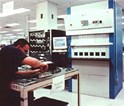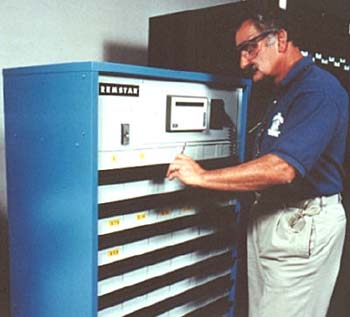Tool Dispensing System Boosts Boeing Division's Bottom Line

Headquartered in a modern, 2 million ft2 complex 20 miles east of the Phoenix metropolitan area, The Boeing Co.'s Rotorcraft Division (Mesa, AZ) produces the AH-64D Apache Longbow combat helicopter, highly reliable medium-caliber cannons for worldwide distribution, and a range of electrical subassemblies for Boeing-produced combat and commercial aircraft.
Boeing has organized several programs that place it in the forefront of technology development for rotorcraft systems. Examples include:
• The Rotorcraft Pilot's Associate, a software program designed to control helicopter combat mission activities.
• The Canard Rotor/Wing aircraft that lifts off like a helicopter and converts to a high-speed, fixed-wing craft.
• The NOTAR system that eliminates the need for conventional helicopters to use tail rotors while making them quieter, safer and easier to maintain.
Gaining and maintaining this kind of industry position requires an operation that is efficient, organized, and cost-effective. One area where Boeing recognized the need to improve productivity was in its tool storage and dispensing systems. Until recently, these functions were completely manual.

Tooling Manager John Simons, Manufacturing R&D Technologist Richard Tuzzolino, and Manager of Tool Control Robert Withrow teamed up to review their options. Ultimately, they selected a system from Remstar International Inc., a provider of automated storage and retrieval systems headquartered in Westbrook, ME.
System Details
The company now uses four Sentinel TS120 and one TD-10 automated tool dispensers. The system offers point-of-use storage with unattended access in work cells for storage of small parts, perishable and durable tooling, and gages of various sizes.
The Sentinels are used in the manufacturing and assembly of the AH-64D Apache helicopter, and in its wire harness facility. The units feature six sliding doors with see-through windows, security carriers, and dividers. The unit allows operators to return tools after they are used or tools that need to be calibrated. This increases tool availability while allowing tracking of usage and calibration.
The system provides increased productivity and security, reduced inventory shrinkage, and access accountability. In addition, the Sentinel units' relatively small footprint (51 in. wide by 45 in. deep) and ability to utilize the available ceiling height has allowed Boeing to maximize available space.
Addition of bar-code technology to the storage and retrieval units augmented the company's security, as well as employee accountability. "We've made the Sentinels bar code compatible, so that employees have to swipe their badge to gain access," Tuzzolino said. "It helps us keep closer tabs on our extensive parts and tool inventory."
The TD10 is an automated tool dispensing system designed to store and dispense individual indexable inserts and round tools up to 8.5 in. long and 0.625 in. diam.

The unit can handle 60 or more tool types, a capability that allows Boeing to group a wide range of tools in one area. The machine's cycle time is just 5 sec, meaning that tools can be dispensed rapidly and employees can return to their task.
The system can be accessed via an industrial keyboard and a bar code reading wand or infrared card reader, but is also linked to a touch-screen system. The setup helps Boeing track tool-related data, which are maintained and posted to reports of transaction and inventory status.
All picking, return, or restocking transactions are logged and are available as one of the more than 100 reports the system's CribMaster software offers. The software allows users to automate tool storage, retrieval, and tracking. Designed for Windows 95 or NT, it can track expendable, durable, and reworkable tools, as well as gages and kits. The package not only controls the manual cribs and locations, but also drives and manages automated retrieval systems. Boeing also is looking into the possibility of using the software to send electronic purchase orders directly to vendors.
Bottom-Line Benefits
The system has reduced Boeing's perishable and durable tool usage per employee by more than 60%. It has also allowed consolidation from eight tool cribs to seven. From the standpoint of accountability, the company now knows exactly where a tool is at any given time.
Point-of-use access provides substantial time savings. For shop-floor personnel, accessing materials now involves a 30-sec transaction instead of a five-minute walk. And since employees can now spend more time at their work stations, overall productivity has been increased.
Boeing has installed three additional Sentinels, and the company could further expand the system later this year to support activities in the Flight Testing area and on the assembly line.
Remstar International Inc., 41 Eisenhower Drive, Westbrook, ME 04092-2032. Phone (800) 639-5805; fax (207) 854-1610.
